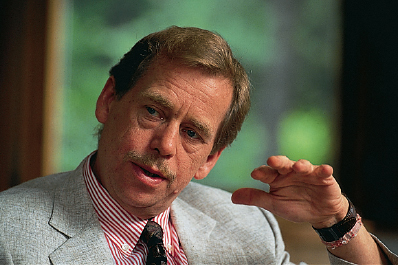Understanding World Societies:
Printed Page 1018
INDIVIDUALS IN SOCIETY
Václav Havel

On the night of November 24, 1989, the revolution in Czechoslovakia reached its climax. Three hundred thousand people had poured into Prague’s historic Wenceslas Square to continue the massive protests that had erupted a week earlier after the police savagely beat student demonstrators. Now all eyes were focused on a high balcony. There an elderly man with a gentle smile and a middle-
Born in 1936 into a prosperous, cultured, upper-
In 1968 the Soviets rolled into Czechoslovakia, and Havel watched in horror as a tank commander opened fire on a crowd of peaceful protesters in a small town. “That week,” he recorded, “was an experience I shall never forget.”* The free-
Havel’s thoughts and actions focused on truth, decency, and moral regeneration. In 1975, in a famous open letter to Czechoslovakia’s Communist boss, Havel wrote that the people were indeed quiet, but only because they were “driven by fear. . . . Everyone has something to lose and so everyone has reason to be afraid.” Havel saw lies, hypocrisy, and apathy undermining and poisoning all human relations in his country: “Order has been established — at the price of a paralysis of the spirit, a deadening of the heart, and a spiritual and moral crisis in society.”†
Yet Havel saw a way out of the Communist quagmire. He argued that a profound but peaceful revolution in human values was possible. Such a revolution could lead to the moral reconstruction of Czech and Slovak society, where, in his words, “values like trust, openness, responsibility, solidarity and love” might again flourish and nurture the human spirit. Havel was a voice of hope and humanity who inspired his compatriots with a lofty vision of a moral postcommunist society. As president of his country from 1989 to 2003, Havel continued to speak eloquently on the great questions of our time.
QUESTIONS FOR ANALYSIS
- Why did Havel oppose Communist rule? How did his goals differ from those of Dubček and other advocates of reform communism?
- Havel has been called a “moralist in politics.” Is this a good description of him? Why or why not?

DOCUMENT PROJECT
How did people in Czechoslovakia overturn the existing social and political order? Explore the efforts of dissidents to produce a peaceful revolution, and then complete a quiz and writing assignment based on the evidence and details from this chapter. See Document Project for Chapter 32